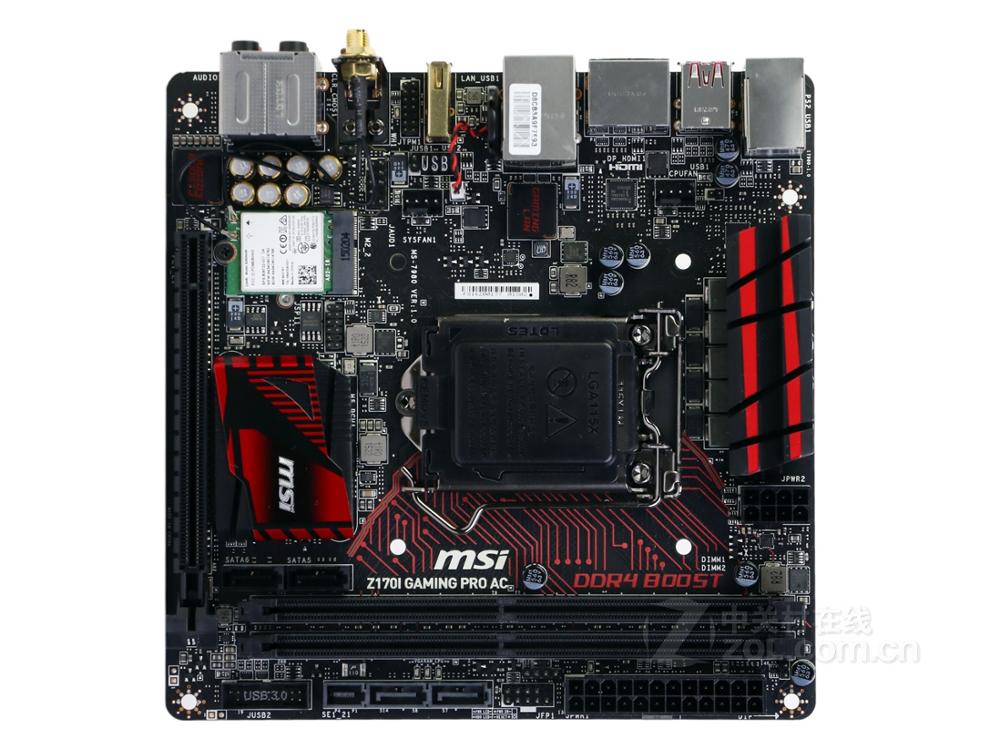MSI Z170I Gaming Pro AC: Review | Test |Specs | CPU Perfromance | Hashrate| Set-up| Config| Pros & Cons – After big, plump motherboards for the latest Intel “Skylake” processors, I named the Gigabyte Z170X Gaming 7 (tested here) and Z170X Gaming G1 (tested here) today it’s the turn of a very small model that I will turn to, the MSI Z170i Gaming Pro AC! Under this barbaric name hides a motherboard in mini-ITX format equipped with the latest Z170 chipset from Intel, DDR4 memory slots as well as a high-end audio part and all the components that go well for “gamers”.
Mini-ITX motherboards have been on the rise lately with the arrival of Steam machines and the mass adoption of PCs easily installed next to a TV, manufacturers are starting to fight by adding always more equipment on this type of card, offered at a price of around 160 €, the MSI Z170i Gaming Pro AC could be an excellent card, especially seeing what it offers, but let’s not go straight to the conclusion!
Specification: Hashrate – MSI Z170i Gaming Pro AC
| MSI Z170i Gaming Pro AC | |
|---|---|
| Format | mini-ITX (17 cm x 17 cm) |
| Socket | Intel LGA 1151 |
| CPU | Intel Celeron / Pentium / Core i3 / Core i5 / Core i7 |
| Chipset | Intel Z170 |
| Memory | 2 x DDR4 2133 Mhz “Dual Channel” Support XMP Maximum de 32 Go Jusqu’à 3200 MHz (OC) |
| Slots d’extensions | 1 x PCIe 3.0 16X (working in 16X) |
| Multi-GPU | Non |
| Audio Chipset | Realtek® ALC1150 |
| Wired Network | 1 x Intel® I219-V Gigabit LAN Controller |
| Wireless network | 1 x Intel® Dual Band Wireless-AC 8260 Wifi 802.11 a/b/g/n/ac Bluetooth 4.1 |
| Number of connectors for fans | 2 x 4-pin PWM |
| Storage | 4 x Sata 6 Gb / s connectors 1 x M.2 slot (Pcie 4x or Sata 6 Gb / s) |
| USB | Back panel: 4 x USB 3.1 Gen1 3 x USB 2.0 / 1.1 Internal connectors: 1 x USB 3.1 Gen1 1 x USB 2.0 |
| Video outputs | 1 x DisplayPort 1 x HDMI |
| Price | ~ 160€ |
The least we can say is that MSI has managed to fit a good bunch of stuff onto the little 17cm motherboard, there clearly won’t be a lot of unused space on it! Of course, who says Z170 chipset says compatibility with latest generation Intel processors, from Celeron to Core i7, including Pentium and core i3 / i5. By changing the socket, Intel also took the opportunity to switch its entire world to DDR4 (even if they remain backward compatible with DDR3, if the motherboard accepts it) which already equipped the high-end in socket X99 instead. of aging DDR3. The base frequency of DDR4 is 2133 MHz, but MSI announces that it will be possible to install modules up to 3200 MHz, which will then be considered as overclocking (like DDR3 at more than 1600 MHz for the latest processors on socket 1150). The memory operation remains in “Dual Channel” as on the previous consumer socket, 2 slots available for a total of 32 GB maximum.
Regarding the expansion ports there is no miracle on a mini-ITX motherboard, we are entitled to a PCIe 3.0 16x port and that’s it! Nothing that changes from the ordinary though 😉 In addition to this PCIe port MSI has also managed to install an M.2 port on the back in order to install an SSD.
The Z170i Gaming Pro AC is not left out in terms of integrated components, there is a very good quality Intel I219-V network controller accompanied by an 802.11 a / b / g / n / ac / Bluetooth 4.1 WiFi card. still from Intel (the Wireless-AC 8260) and a Realtek® ALC1150 audio chipset accompanied by high-end capacitors, enough to cover all the needs of a person looking to make a mini-ITX configuration.
Regarding storage, it is also very good with the presence of 4 Sata 6 Gb / s ports managed by the Intel Z170 chipset in addition to the M.2 port, enough to connect a quite acceptable number of peripherals, if more is needed, so a mini-ITX configuration is not necessarily the most suitable!
Offered at around 160 € and given the features present it is clear that it has strengths for it, if the goal is to overclock the processor and have a lot of features, let’s see what it has in its belly!
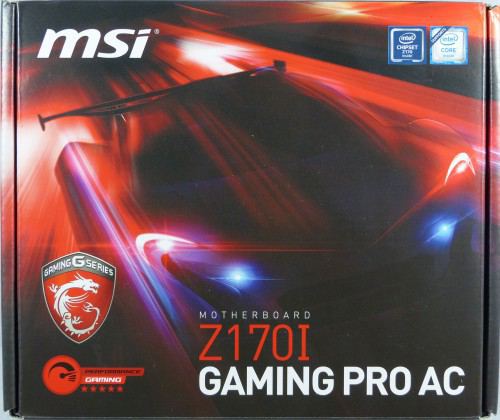
MSI is in the “gamer” color of the moment, namely red and black for its box. On the front side we find the logo of the brand, the model as well as the Intel Core and Intel Z170 logos. A small counter is present showing how good the performance is, with even small stars to back it up, I find it hard to see the interest, apart from purely marketing, but hey 😉
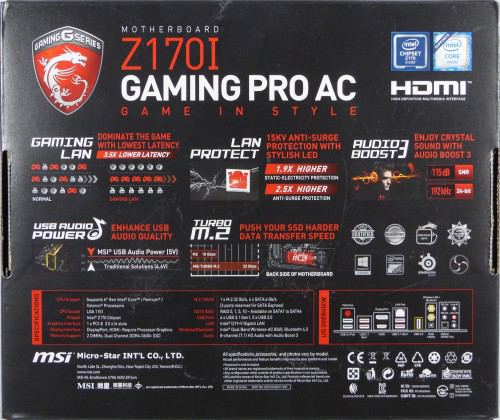
At the back is a listing of the different strengths of the beast, “gamer” network chipset which allows “dominance” with a lower latency (which once again is nothing other than a prioritization of the packets when the connection is used. by many programs at the same time, I remind you that a network chipset can in no way improve the ping during normal use), a network port protected from surges, a high-end sound part, an M.2 port etc. There is also a technical description and a diagram of the connectors on the back of the card.
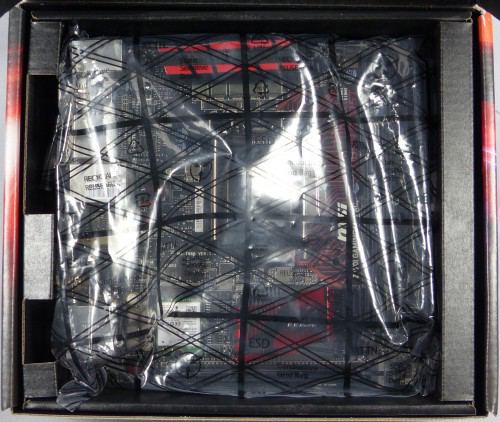
When opening the box, we find the antistatic bag containing the Z170i Gaming Pro AC, well surrounded by its box.
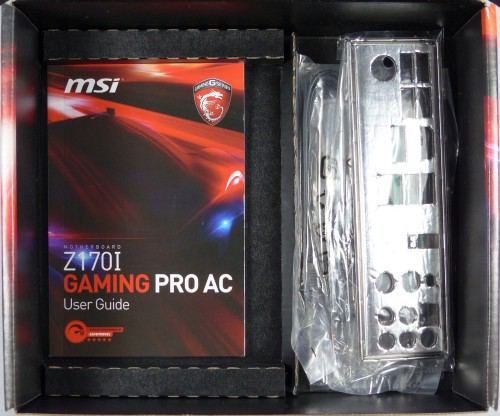
Under the cardboard box of the motherboard we have access to the bundle, which we will see immediately!
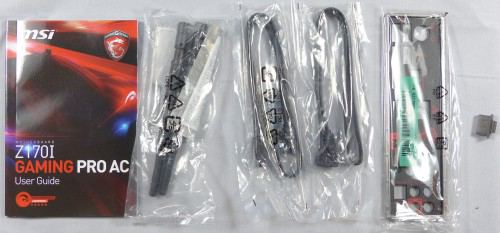
The bundle consists of:
- 2 x WiFi antennas
- 2 x Sata 6 Gb / s cables
- 1 x I / O plate
- 1 x cache HDMI
- 1 x Manuel
As we can see the bundle is rather succinct, MSI goes to the essentials here and anyway it is about a motherboard, besides the Sata cables and the Wifi antennas there is not much to ask , there will be everything the user needs (other than maybe an extra Sata cable or two).
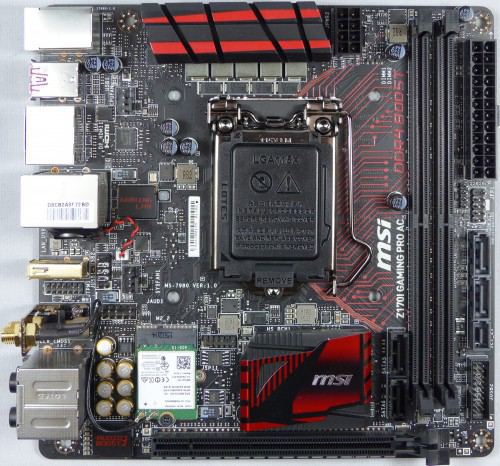
Here is the beast! Mini-ITX obliges the first thing that strikes you is the size, unless you have the card in your hands you don’t really realize. One thing is certain everything is well packed here, components are installed wherever possible.
The build quality is really very good, the card looks solid and inspires confidence. As usual, the dominant colors are black and red, you don’t change a winning team with “gamer” products. Let’s take a closer look at all of this.

The Realtek audio chip has been covered by a small marketing stroke with the inscriptions “Audio Boost”, it is accompanied by Japanese chemicon capacitors specially designed for audio, high quality so a good point for this MSI Z170i Gaming Pro AC. The Wifi / Bluetooth part is removable with its Intel® Dual Band Wireless-AC 8260 card which should ensure very good performance.
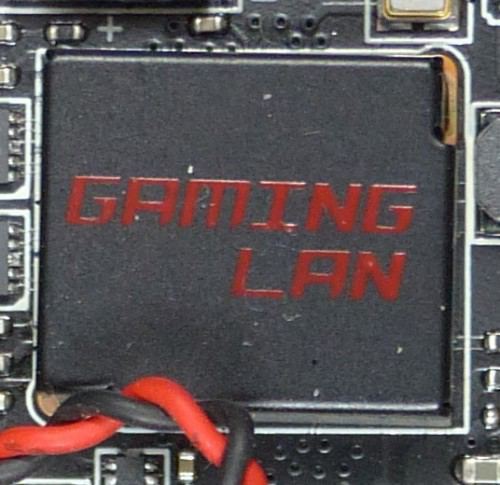
Likewise, the Intel I219-V network controller is covered with a purely marketing inscription “Gaming LAN”, a very good controller which clearly did not need an overlay 😉

4 Sata 6 Gb / s ports are present on both sides of the 2 memory slots (DDR4 I remind you!). It is even possible to install a Sata Express device there if necessary.
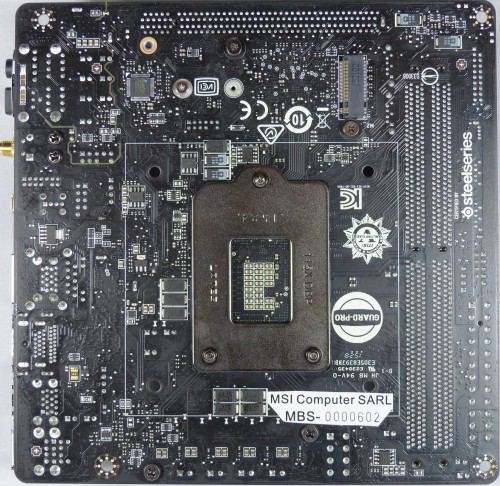
Not content with having filled one side, MSI has still added quite a few small components to the rear, no wonder you have to use the space to the maximum! The build quality is once again very good and we can see that the different radiators are fixed using screws and not plastic picos which can eventually break. A little extra marketing touch comes to the rear via the little “Certified by Steelseries”, will Steelseries peripherals work better with the certified motherboard? Certainly not, in short … let’s move on 😉
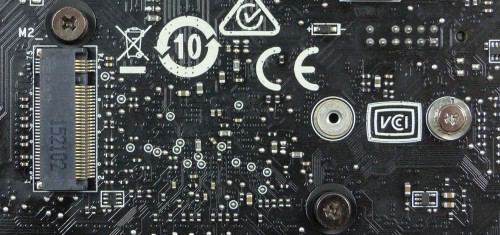
The M.2 port is deported at the back, and yes casually it takes up a lot of space and it’s not really the strong point of a mini-ITX motherboard!

At the back we have the right to (from left to right):
- 1 x port PS/2, 2 x port USB 2.0 / 1.1
- 2 x USB 3.1 / 3.0
- 1 x Display Port, 1 x HDMI
- 1 x RJ45 Gigabit, 2 x USB 3.1 / 3.0
- 1 x USB 2.0 / 1.1
- 2 x connectors for the WiFi antenna, 1 Clear CMOS button
- 1 x sound panel
Despite the small size of the motherboard, the back is rather well supplied, 4 USB 3.1 ports, 3 USB 2.0 ports as well as the eternal RJ45 gigabit port and of course the sound connectors and antennas. A Clear CMOS button is also present for those who indulge in overclocking and who would no longer be able to start the machine, it can be interesting not to have to open the case each time!
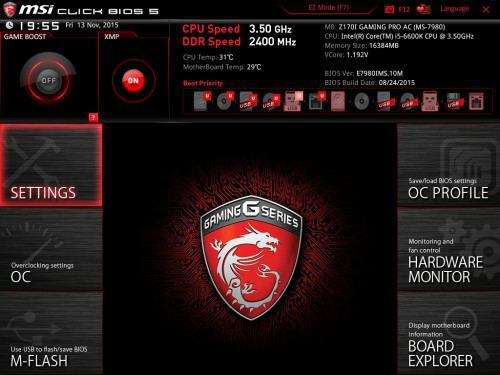
Here is the BIOS welcome screen, the “gaming” colors are once again out, red and black everywhere! The interface is pretty clear, the fingernails are on the left and right of the screen, hardware information is at the top of the screen. There are 2 buttons at the top left, 1 to activate / deactivate the XMP profile of memory modules and another called “Gaming Boost”, what can the latter mean? Let’s see this:
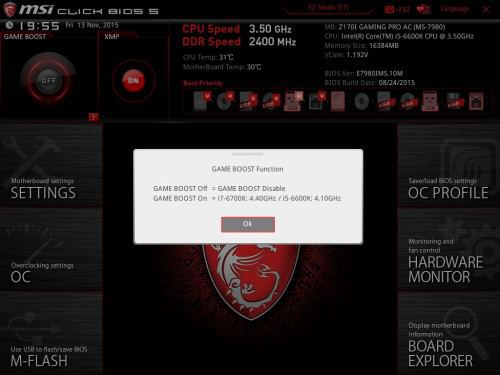
What MSI calls “Game Boost” is none other than an automatic overclocking feature, as we can see in the screenshot a Core i7 6700K will be overclocked to 4.4 GHz while a Core i5 6600K will go up to 4.1 GHz, a “gaming” marketing name for a feature that will not change much to “in game” performance but which can be useful to neophytes who do not want to engage in manual overclocking.
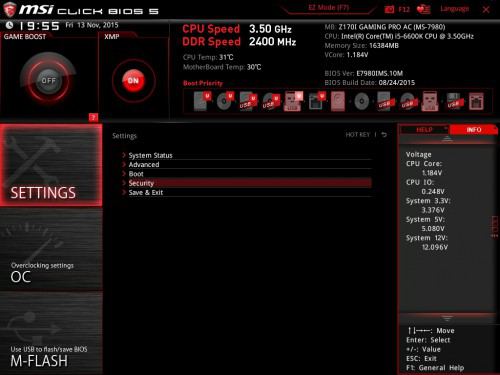
The “Settings” tab is split into several parts, which we will see right away:
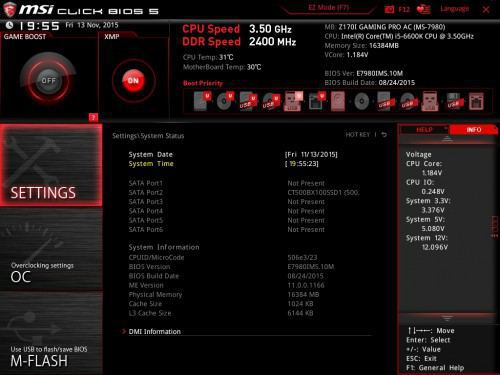
“System Status” offers a global view of the components installed on the Sata ports, as well as information on the motherboard (BIOS, processor ID, PCB version etc.)
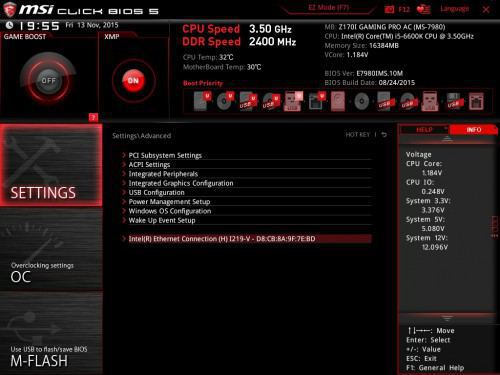
In “Advanced” as its name suggests, you have access to advanced BIOS settings, enable / disable onboard peripherals, enable / disable the GPU integrated into the processor, configuration of USB ports and so on.
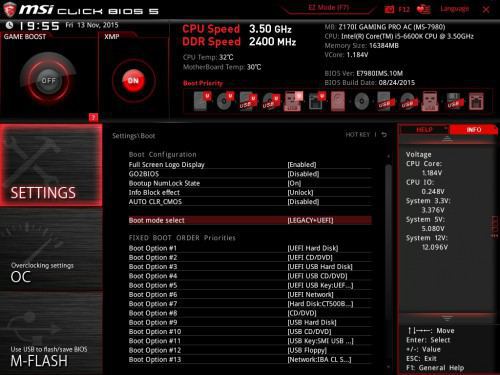
The “Boot” tab of course allows you to manage the priority of the boot devices, and as much to say that the list is long!
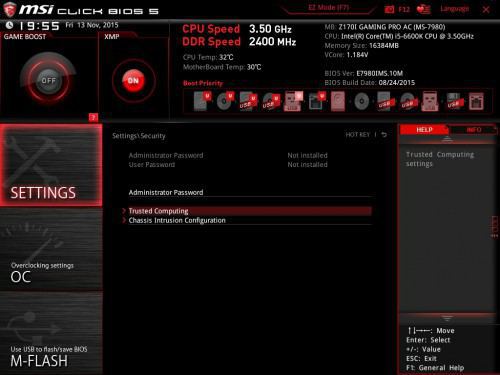
“Security” allows you to set a BIOS password to limit access and set up the chassis intrusion option.

Finally, with the “Settings” tab, the “Save & Exit” section allows you to save the settings, reset them as well as quickly change the priority of the peripherals at startup.

Now let’s move on to the “OC” tab, the sinews of war for some people, here despite the reduced size of the map there is a very large majority of settings allowing you to push the equipment well, the first option “OC Explore mode »Allows you to activate or deactivate the advanced settings. Voltages and frequencies are changeable whether it is for the CPU or the memory, for a small card like this one there is not really to complain.
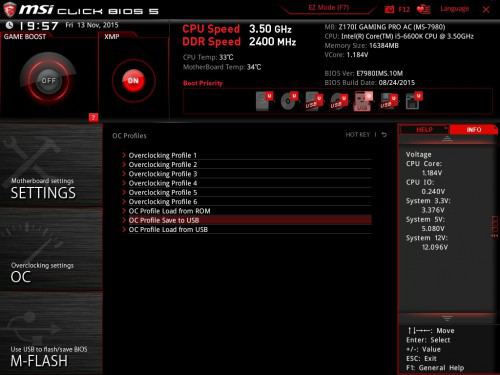
Let’s move on to the right tabs now, the “OC Profile” part allows you to save and load profiles, it will be possible to do this either directly in the BIOS or on a USB key (in case a clear CMOS is necessary for example) .
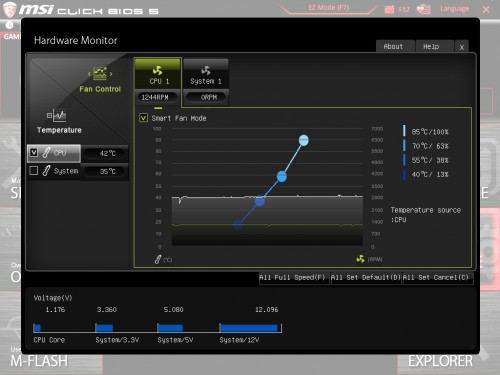
“Hardware monitor” is used to control the fans installed on the motherboard, the curve of the fans can be modified according to our wishes in relation to the temperature of the processor.
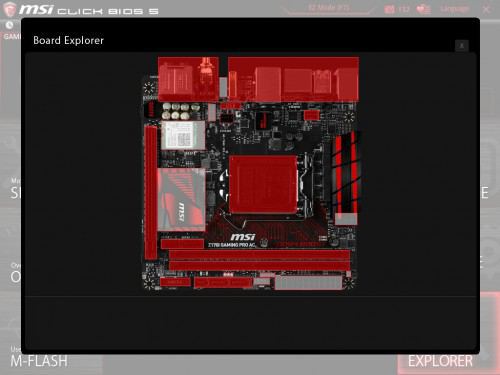
“Board Explorer” is a rather special tab, by hovering over the different parts of the map explanations will be given, this can be interesting for beginners who do not know what the different components of the board correspond to.
The BIOS tour is now complete! To summarize, we can say that MSI offers a completely complete BIOS which will be largely sufficient for all uses, even the most demanding.
MSI offers us a motherboard with a fairly large panel of software available, without these being essential they can be useful if you want to overclock / adjust your fans / update your bios via Windows. I’ll take a quick tour of the main software available:
MSI Command Center

MSI Command Center is the software that will allow you to touch the frequencies and different voltages of the processor and memory, in other words overclocking! When launching, we go directly to the “CPU” tab, various information is present, the current processor frequencies as well as a ventilation curve. Each parameter is configurable and modifiable on the fly.
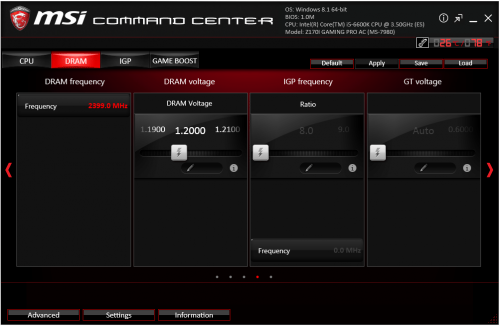
The “DRAM” and “IGP” tabs provide access to the various voltages, Memory and IGP, but very few settings are available.
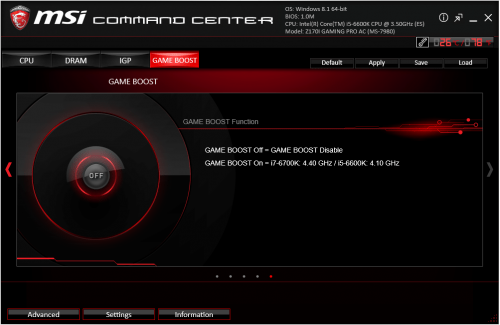
“Game Boost” is also present here, in the same way as the BIOS it will be possible to overclock a Core i7 6700K to 4.4 GHz and a Core i5 to 4.1 GHz with a single click.
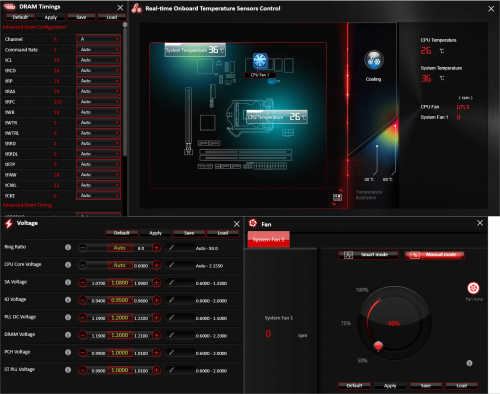
In “Advanced” much more precise settings are available, memory latencies, fan settings, processor voltages etc.
MSI DPC Latency Tuner
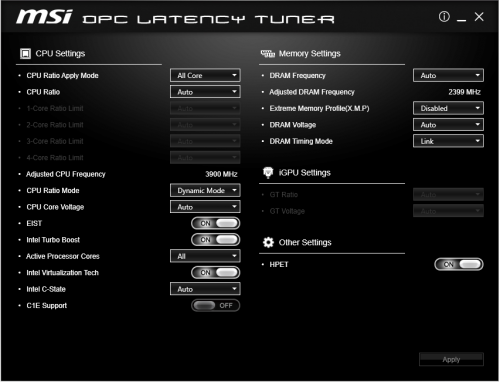
Similar to the command center, the DPC Latency Tuner utility allows you to change frequencies on the fly, overclock the processor, disable / enable certain power saving features as well as touch memory settings.
MSI Gaming APP
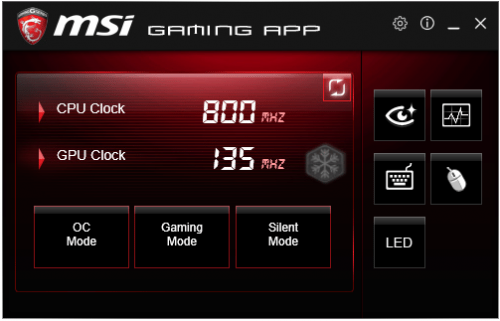
The MSI Gaming App utility allows you to manage the frequencies of the processor and the graphics card in 1 click, according to pre-recorded parameters. For example with the “Gaming” mode the processor goes directly to 3900 MHz (even at rest) and the graphics card at its maximum operating frequency (if an MSI graphics card is installed) while the “Silent” mode returns the processor to its original idle frequencies (i.e. 800 MHz, but still 3900 MHz under load) and the graphics card at very slightly lower frequencies.
In addition to that several buttons are available on the right, here is:

Several nice little tools here, it will be possible to do macros on the keyboard / mouse, and this with any model, which can be interesting. In addition to that an OSD is available and can display a lot of information on the screen during games (temperatures, frequencies, memory usage etc.) as well as modify the colors of the screen according to the type of use (brighter color during games, lower brightness with “EyeRest” mode, etc.).
MSI Gaming LAN Manager
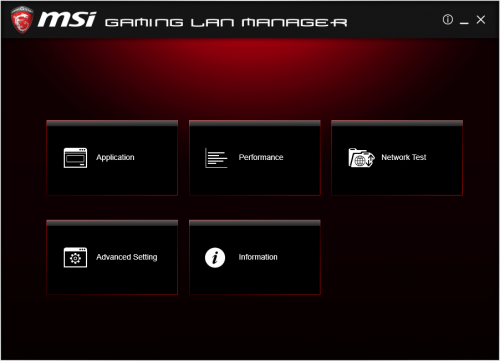
Under this very marketing name hides a software overlay allowing the prioritization of the packages, for example when a game is launched and a streaming video is played at the same time the software will make sure to give priority to the game rather than to the video in order to maintain an acceptable ping during the game. Quite honestly the usefulness of this kind of utility is very limited, if the connection can’t keep up when a game is started and different software is using the bandwidth then I would strongly advise cutting the unnecessary software.
The test platform
The MSI Z170I Gaming Pro AC has been tested with the configuration below:
- Processor : Intel Core i5 6600K
- CPU Fan : Noctua NH-D15
- Motherboard : Gigabyte Z170X Gaming 7
- Mémoire: Corsair Vengeance LPX DDR4 2 x 4 Go 2666 MHz
- Disque dur: WD Raptor 150 Go
- Carte graphique : XFX 7870 Black Edition
- Ventirad Graphics Card : Arctic Cooling Accelero S1
- Alimentation: be quiet! E9 580CM
In order to have results covering a wide range of applications, I chose the following benchmarks:
- Cinebench R15 : downloadable here
- Handbrake : downloadable here
- 3DMark Fire Strike Physics : downloadable here
- SuperPI 32M : downloadable here
- Aida64 4.60 : downloadable here
- Bioshock Infinite et Shogun 2 Total war
- CrystalDiskMark : downloadable here
The card will be placed in front of the other Z170 motherboard tested at Conseil Config, namely the Gigabyte Z170X Gaming 7 (tested here) and Gigabyte Z170X Gaming G1 (tested here) as well as the older generation Z97 equipped with a Core i5 4670K and its Gigabyte Z97X Gaming G1 Wifi-BK, although the processor and the socket are different this will give an idea of the power difference between the 2 platforms.
Cinebench R15
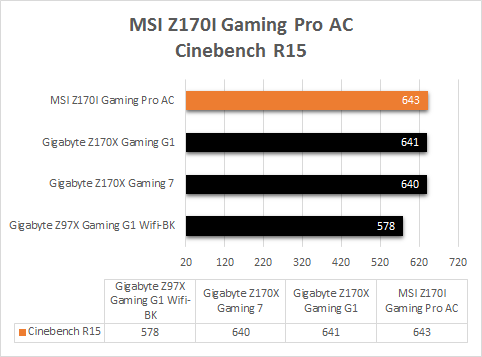
Without surprises here, the results are really very close, the small card from MSI has the luxury of doing very slightly better than the other cards from Gigabyte in the comparison, but nothing that cannot be representative. The results are once again better than the previous generation, without exploding the performance 😉
Handbrake
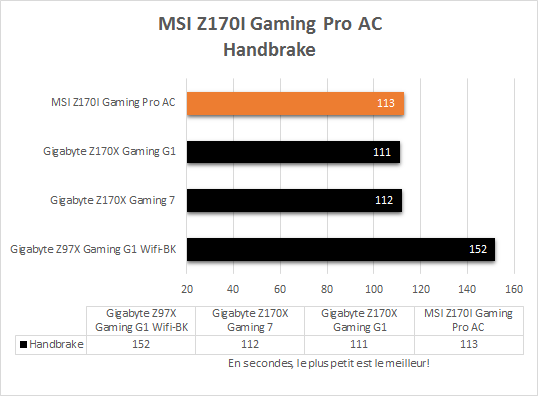
Better on Cinebench R15 but a bit less efficient under Handbrake, we are still very close, however, the old generation based on Z97X chipset is far away, Handbrake is particularly fond of the new architecture from Intel.
SuperPI 32M
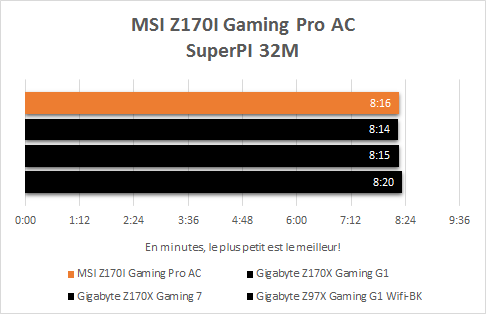
The performance does not change much under SuperPI 32M, we go from 8min20s for the old Core i5 to 8min16 for the MSI Z170T Gaming Pro AC, results which are again almost identical to those found on other cards. Z170 of the comparison.
Aida64 5.3
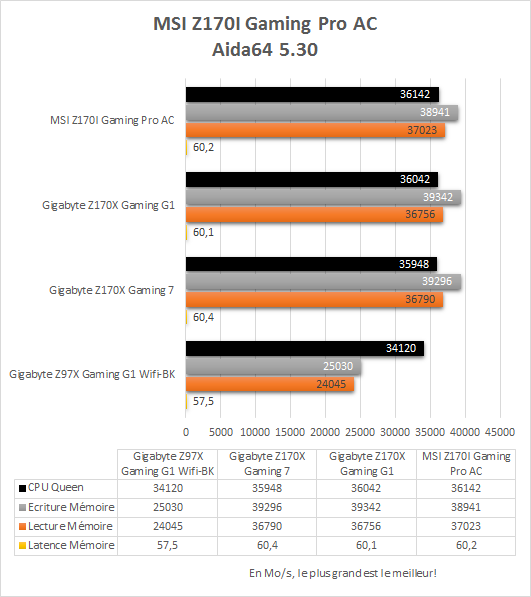
The memory controller being directly integrated into the processor, the motherboard does not really have a say in the flow, so logically once again the results are almost identical between all Z170 motherboards. The difference between the Core i5 4670K and the Core i5 6600K is clearly marked here and this is normal given that the memory used for the 4670K is DDR3 1866 MHz against DDR4 2666 MHz for the 6600K, on the other hand like the memory has a very questionable effect on practical results it will not change much.
3DMark Fire Strike and Games
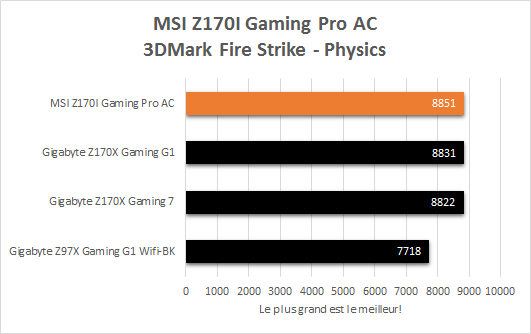
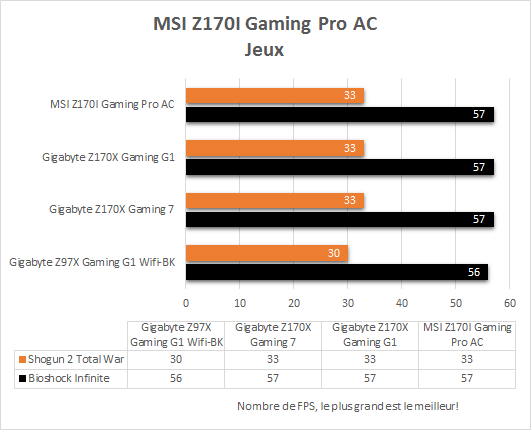
We see a gain of about 14% in the processor benchmarks of 3DMark Fire Strike, the “old” i5 4670K is content with 7718 when the new 6600K goes up to 8851 (MSI Z170I Gaming Pro AC), 8822 (Z170X Gaming 7) and 8831 (Z170X Gaming G1), a significant gain. In practice on the other hand we gain about 10% on Shogun 2 Total War which is very dependent on the CPU used, against only 1 small FPS under Bioshock which on the other hand requires more graphics power than processor. That said, these results are only indicative, it would be necessary to analyze the processors on different types of games (and with a more powerful graphics card) to really get an idea of the difference between the 2 architectures, which doesn’t is not the goal in this article!
Debits Sata CrystalDiskMark
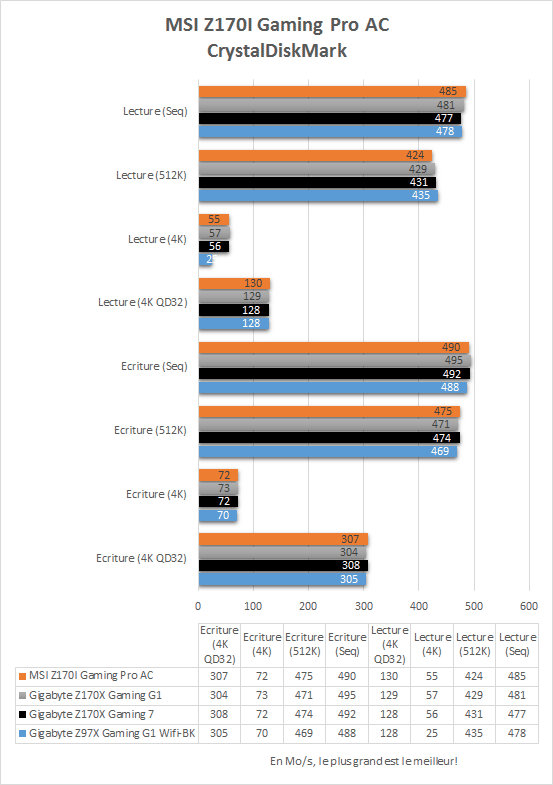
Nothing to report here, the speeds are identical between the 4 motherboards, nothing surprising that said when we know that the Z97 chipset is already excellent, the Z170 continues the momentum.
Ethernet / Wifi speeds
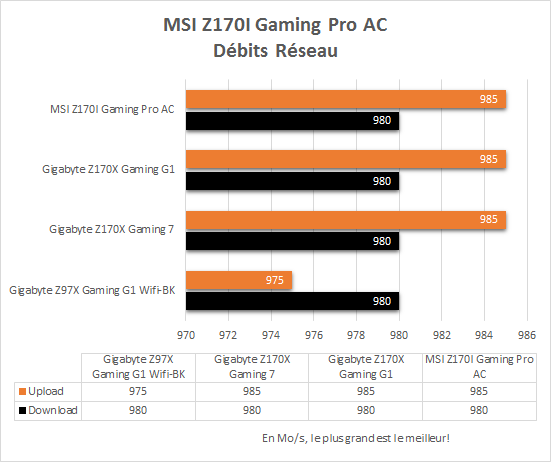
The Intel network chipset is excellent as usual, reaching speeds of up to 985 Mb / s in download and 980 Mb / s in upload, very good results which will be sufficient for the vast majority of users. Regarding the MSI Gaming software overlay as usual there is absolutely no difference whatsoever in game ping or speeds, as long as the connection is not saturated this type of software will be completely useless.
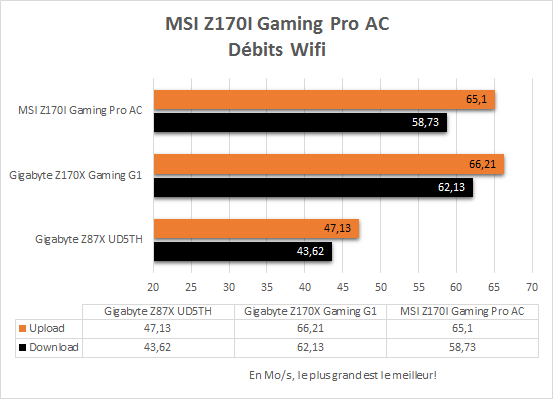
Since the MSI Z170I Gaming Pro is equipped with a WiFi chipset it was only put in front of the Gigabyte Z170X Gaming G1 and Z97X Gaming G1, since the Z170 Gaming 7 does not. The WiFi has been tested in real conditions, and not glued to a high-end router specially purchased for the occasion, in fact in 99% of cases the PC is connected to the box so it will be the same for this test! The connection is made to a SFR NB6 box (optical fiber with speeds of 1Gb / 200Mb) and through a wall.
As we can see the results are very good on the MSI card, quite identical to the results that can be observed on the excellent Gigabyte Z170X Gaming G1, reaching a maximum of 58.73 Mb / s in download and 65.1 Mb / s in upload, it goes without saying that a person with access only to ADLS2 + will be constrained by the connection and not the Wifi chipset of the motherboard but with an optical fiber connection it will be the reverse !
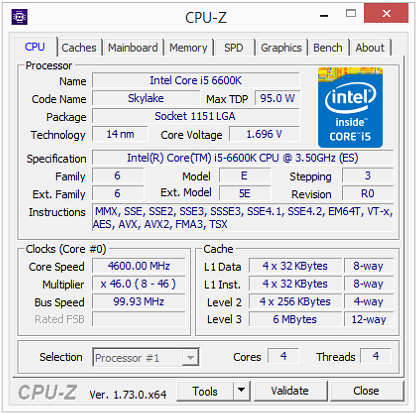
As with the other Z170 motherboards that I have had in my hands, the processor reaches its limits here with a maximum of 4600 MHz, for a voltage of 1.28V (do not take into account CPU-Z which has a bit of trouble see the real voltage 😉), the little MSI Z170I Gaming Pro AC clearly has some under the hood and is quite capable of overclocking (as long as the ventilation is there of course, you should not think too much about doing this in a poorly ventilated mini-ITX box).
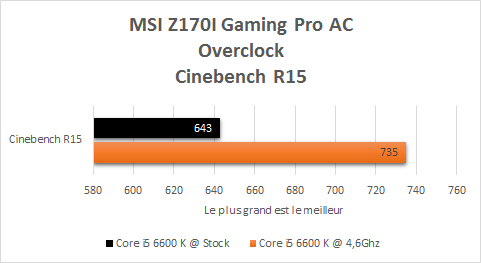
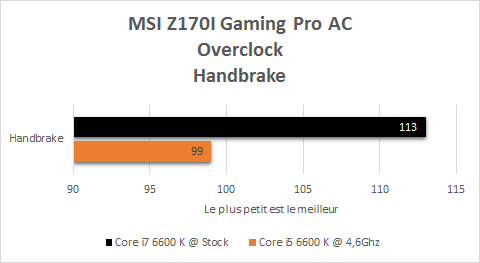
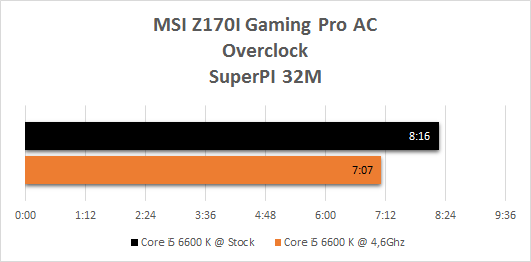
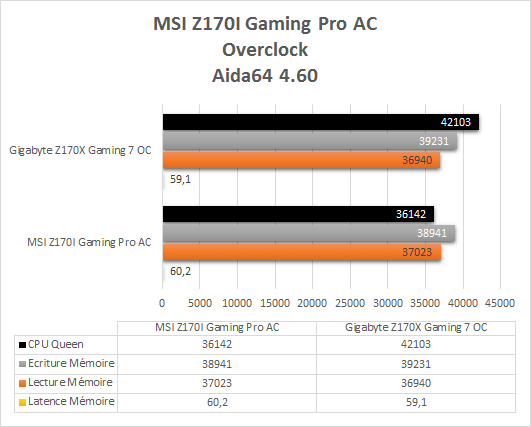
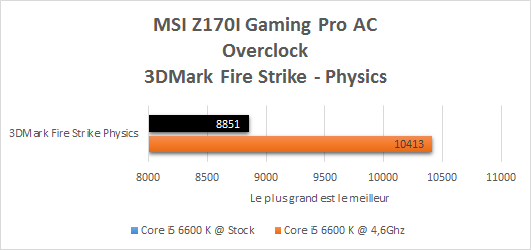
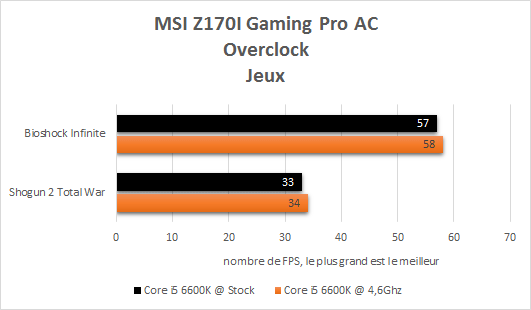
As for the other motherboards tested, the results perfectly reflect the increase in frequency of the processor, especially software using mass multicore like Handbrake and Cinebench, it is clear that the encoding or the calculation software will be in heaven. In games, however, the gain is marginal, as one might have suspected.
In the end, the MSI Z170I Gaming Pro AC behaved perfectly well, no instability to report, it must however be remembered that each processor is different, if my copy was able to climb to a frequency of 4.6 GHz it may be that others do not succeed, or they do better!
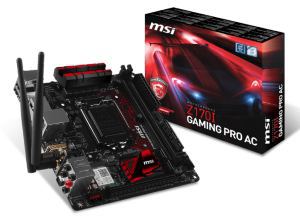
Here we are at the end of this test, what about the MSI Z170I Gaming Pro AC?
MSI offers here one of the first motherboards with a Z170 chipset in mini-ITX format, which says mini-ITX generally means less functionality than its big ATX sisters but MSI has been able to combine the best of both worlds. The build quality is excellent, the performance as well and the overclocking is no exception.
In addition to this, the card is equipped with high-end components, whether it is the audio part with hi-fi capacitors, the network chipset as well as the Intel WiFi card, everything to have a high-end mini-ITX gamer configuration.
Offered at a price of around 160 € it goes without saying that it will not be for all budgets, knowing that a cheaper motherboard will have equivalent performance in games but its strengths make it an excellent choice for who wants to have everything on a motherboard in mini-ITX format.
Advantages
- Build quality
- Sound / network chipsets
- Features
- Look?
A big thank you to Brice from MSI who allowed me to do this test.





